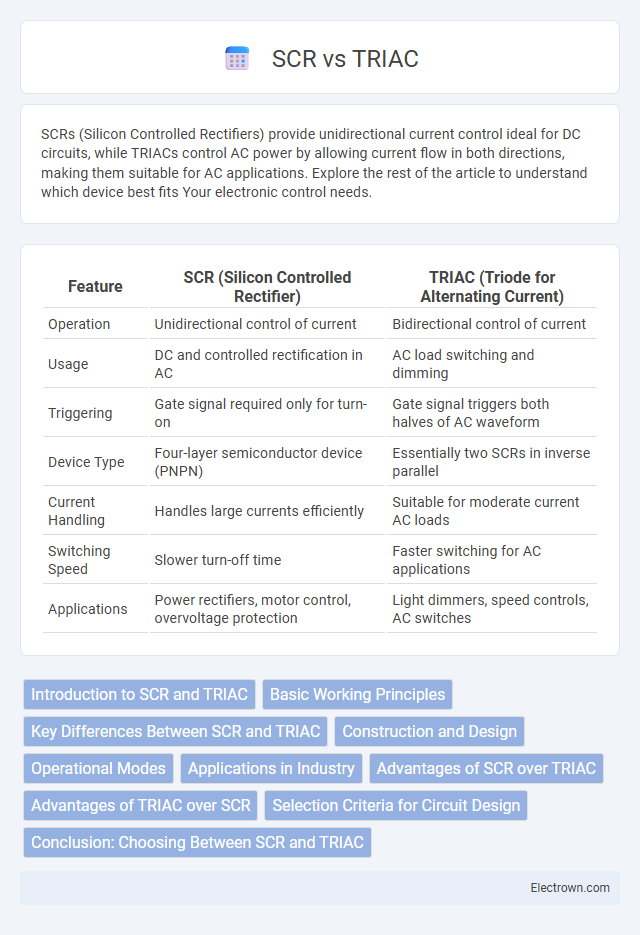SCRs (Silicon Controlled Rectifiers) provide unidirectional current control ideal for DC circuits, while TRIACs control AC power by allowing current flow in both directions, making them suitable for AC applications. Explore the rest of the article to understand which device best fits Your electronic control needs.
Table of Comparison
| Feature | SCR (Silicon Controlled Rectifier) | TRIAC (Triode for Alternating Current) |
|---|---|---|
| Operation | Unidirectional control of current | Bidirectional control of current |
| Usage | DC and controlled rectification in AC | AC load switching and dimming |
| Triggering | Gate signal required only for turn-on | Gate signal triggers both halves of AC waveform |
| Device Type | Four-layer semiconductor device (PNPN) | Essentially two SCRs in inverse parallel |
| Current Handling | Handles large currents efficiently | Suitable for moderate current AC loads |
| Switching Speed | Slower turn-off time | Faster switching for AC applications |
| Applications | Power rectifiers, motor control, overvoltage protection | Light dimmers, speed controls, AC switches |
Introduction to SCR and TRIAC
Silicon Controlled Rectifiers (SCRs) are semiconductor devices used primarily for controlling high voltage and current in applications requiring unidirectional current flow. TRIACs, on the other hand, can conduct current in both directions, making them ideal for AC power control in dimmers, motor speed controls, and switching devices. Your choice between SCR and TRIAC depends on whether you need control over DC or AC circuits and the directionality of current flow.
Basic Working Principles
SCR (Silicon Controlled Rectifier) operates as a unidirectional device that allows current flow only after its gate receives a triggering pulse, remaining on until the current drops below a certain threshold. TRIAC (Triode for Alternating Current) functions as a bidirectional switch enabling current flow in both directions when triggered by a gate signal, making it ideal for AC control. Your choice between SCR and TRIAC depends on whether unidirectional or bidirectional control suits your application requirements.
Key Differences Between SCR and TRIAC
SCR (Silicon Controlled Rectifier) is a unidirectional device that allows current to flow only in one direction, making it ideal for DC control applications, while TRIAC (Triode for Alternating Current) can conduct current in both directions, enabling control of AC power. SCR requires a continuous gate signal to remain on once triggered and turns off only when current drops below a holding level, whereas TRIAC can be triggered by either positive or negative gate pulses and turns off when the current falls below its holding current during each AC cycle. Your choice between SCR and TRIAC depends on whether you need to control AC or DC signals and how you plan to manage triggering and turn-off conditions in your circuit.
Construction and Design
SCRs (Silicon Controlled Rectifiers) feature a four-layer semiconductor structure (PNPN) with three junctions, designed for high current and voltage control in power electronics. TRIACs, constructed as two SCRs connected in inverse parallel within a single package, enable bidirectional current flow for AC applications. The compact TRIAC design allows switching in both halves of the AC cycle, while SCRs control current in only one direction.
Operational Modes
SCR (Silicon Controlled Rectifier) operates primarily in a latching mode, meaning once triggered by a gate pulse, it remains on until the current drops below a holding threshold. TRIAC (Triode for Alternating Current) functions in bidirectional switching mode, allowing current to flow during both positive and negative half-cycles of AC, making it ideal for AC power control. SCRs are typically used for controlled rectification in DC circuits, whereas TRIACs are suited for AC applications requiring phase control and dimming.
Applications in Industry
SCRs (Silicon Controlled Rectifiers) are widely used in industrial applications requiring high power control, such as motor speed regulation, power conversion, and controlled rectification in DC drives. TRIACs are preferred in AC power applications including light dimming, heater control, and low-to-medium power motor speed control due to their ability to conduct current in both directions. Industries choose SCRs for high-voltage and high-current applications, while TRIACs efficiently manage lower power AC loads with simple triggering methods.
Advantages of SCR over TRIAC
SCRs offer superior control in high-voltage and high-current applications, providing fast switching speeds with high efficiency. Their unidirectional operation minimizes electrical noise and enhances reliability in precise power regulation. Your system benefits from SCRs' better handling of power surges and thermal stability compared to TRIACs.
Advantages of TRIAC over SCR
TRIACs offer the advantage of controlling AC power by conducting in both directions, enabling efficient phase control without the need for additional components to handle reverse polarity. Unlike SCRs, TRIACs simplify circuit design by eliminating the requirement for separate devices for each half-cycle, which reduces cost and improves reliability. Their bidirectional operation makes them ideal for applications such as light dimmers, motor speed controls, and AC switches, providing smoother and more versatile power regulation.
Selection Criteria for Circuit Design
SCRs offer precise control over high-voltage and high-current applications due to their ability to handle large power loads and latch in the on state, making them suitable for circuits requiring steady conduction. TRIACs provide bidirectional control, ideal for AC switching and dimming applications where bidirectional current flow and simpler triggering are essential. Your circuit design should prioritize SCRs for unidirectional, high-power control and TRIACs for efficient AC power management and compact switching solutions.
Conclusion: Choosing Between SCR and TRIAC
Selecting between SCR and TRIAC depends on application requirements such as load type, control complexity, and switching performance. SCRs offer superior performance for high-power, unidirectional circuits with greater control precision, while TRIACs excel in bidirectional AC load switching and simplified phase control. Evaluating factors like voltage ratings, switching speed, and circuit simplicity ensures optimal device selection for efficient power management.
SCR vs TRIAC Infographic

 electrown.com
electrown.com